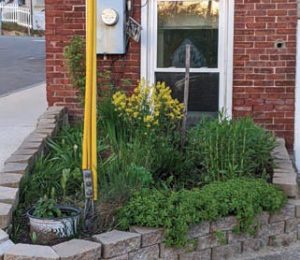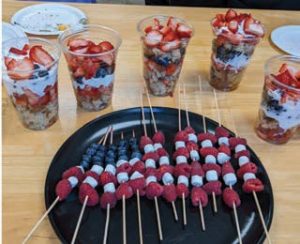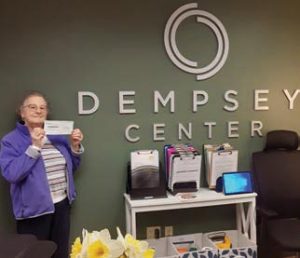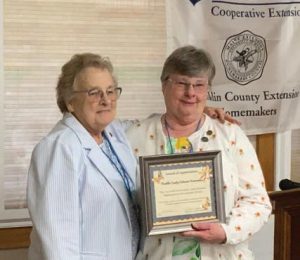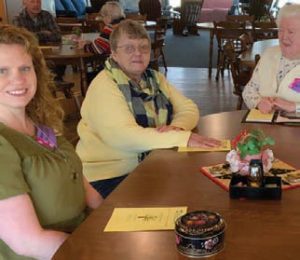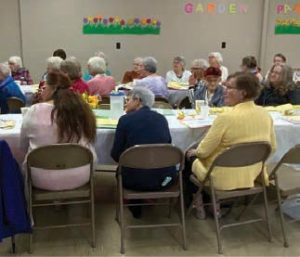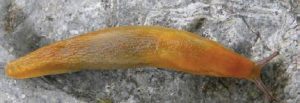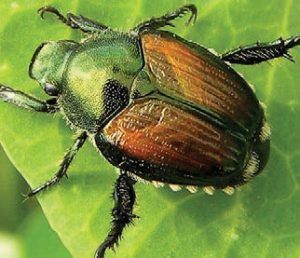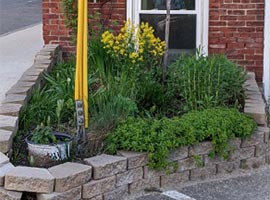
Maine Extension Homemakers Newsletter, Summer 2023
July-September 2023
- Download and Print: Maine Extension Homemakers Newsletter, Summer 2023 (PDF)
Table of Contents
- Presidential Ponderings from Marie Temm
- Around the State
- Janet’s Jammies
- In the Garden and Out in the Yard
- PFAS and Your Home Garden
- Mark Your Calendars
- Maine Happenings Near You July– September
- Staff Highlight
- Maine’s Agricultural Fairs 2023
- Recipe: Skillet Lasagna
- Recipe: Micro-Scalloped Potatoes
- Recipe: Fried Rice
Presidential Ponderings
Dear Maine Extension Homemakers across our great state of Maine,


It was a very wonderful gathering at our Spring Meeting in May. The county groups are meeting and getting out within communities across our state, and there was much joy in being together again. A huge note of thanks to our advisors for all of their hard work in co-hosting the event. We heard all the great things happening within our counties that included fundraisers, tours, scholarships, and donated items. Congratulations to the Franklin County group and its leaders as they are the ALL-STARS of volunteer hours and community service donations. It will be exciting to see what the future brings for us all. I welcome opportunities to visit with each of our county homemaker groups during my presidency.
Best wishes to you all, your MEHC President, Marie Temm
Around The State
Androscoggin-Sagadahoc
Living Innovations Homemakers in Androscoggin County joined forces with Master Gardener Volunteer, Janis M., and a few 4-H members to create a garden space with a seating area behind the Androscoggin and Sagadahoc Cooperative Extension office located in Lisbon Falls. This project will be ongoing. The group also met to learn about Memorial Day. The members wanted to send notes of thanks to living veterans and mailed a stack of cards to the Maine Veterans Home in Augusta. They spent some time celebrating with flag-themed foods.
Aroostook
he New Sweden group of the Aroostook County Homemakers hosted the County’s spring meeting in May with a Swedish theme. A traditional Swedish meal was served and attendees were treated to Swedish Dancing by more than 20 local youth.
Cumberland
The Cumberland County Homemakers held a fundraiser in April at Skillins Greenhouse called
“Cupcakes for Cancer.” Members made nearly 300 cupcakes that sold for $1 each. Along with additional donations, the group raised a total $629 which was double the funds raised in 2022. County co-chair Marie Temm presented a check to the Dempsey Center for Cancer in Portland. The group hopes to double their fundraising efforts next year for a sizable donation to help community members dealing with cancer.
Franklin
The North Chesterville club hosted the Annual Spring Meeting of the Franklin County Extension Homemakers. The theme was “Garden Party” and a guest speaker discussed her experiences with square-foot gardening.
Hancock
Hancock County homemakers welcomed a guest speaker to their May meeting who talked about foraging for and cooking with wild foods. Members were treated to pine needle cookies, a best-seller at the farmer’s market.
Somerset
Clinton Evening Homemakers, in Somerset County, held a class on using Electric Pressure Cookers, and the Cambridge Homemakers held a workshop on pressure canning. Members in Somerset County will be spending the summer making wheelchair caddies and colostomy cover-ups for the Lakewood Nursing Home.
- Androscoggin-Sagadahoc members create new garden space.
- Aroostook County Homemakers spring meeting.
- Cumberland County fundraiser for the Dempsey Center for Cancer.
- Franklin County Homemakers spring meeting.
- Hancock County members gather to hear a guest speaker.
- Somerset County Homemakers spring meeting.
Janet’s Jammies
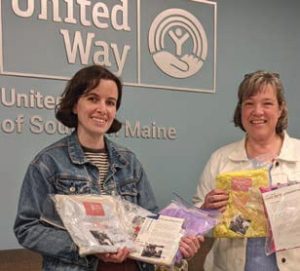
United Way of Southern Maine.
Fourteen sets of jammies were donated to the United Way of Portland in May. They were grateful for the donation and are excited to get the jammies into the hands of young kiddos.
Lorie Swift was recognized by the VFW Auxiliary for her efforts in making Janet’s Jammies as part of the Madison Riparian’s Homemakers. If you would be interested in continuing to sew for Janet’s Jammies, please let Lisa Fishman know so patterns and materials can be distributed. A substantial donation of flannel material has been received to support the effort.
In the Garden and Out in the Yard
Summer is the time to enjoy your garden and yard, but when it’s hot and dry don’t forget to water. A rain gauge will help you determine how much to water your gardens, trees and shrubs. Plants need about 1½ inches of rain on a weekly basis. Be sure to water early in the day to help the roots take up the water, and to allow leaves to dry thoroughly to keep diseases at bay.
Insects can be a problem from the moment the snow melts to the time the first frost hits. This year, tent caterpillars are causing a lot of concern among gardeners. The Maine Forest Service has released a helpful guide to the various caterpillars to look out for, which ones are mere nuisances and which ones are invasive threats, and which ones could cause a rash if they are touched. For more information on the brown tail moth, visit the Maine Forest Service website’s Browntail Moth – Euproctis chrysorrhoea (L.) page.
Slugs are another perennial garden pest that doesn’t take a holiday during the summer. Physically removing the slimy creatures, especially in the mornings when there is just enough dew on plants to attract them, seems to be the best control for them. Japanese beetles will cause a lot of damage to your garden and, again, the best control for them seems to be hand-picking. Repeated passes to eradicate them is very effective. Tomato hornworms are every tomato grower’s nightmare. Spotting the tomato hornworm among the leafy foliage of the plants is more difficult than spotting the poop from the hornworm, so focus on that to locate the camouflaged critters and hand-pick them from your plants. Your tomatoes will thank you.
Stay on top of the weeds in your garden. Pluck and pull them early, before they form seed heads and scatter the seeds on the wind. Keep an eye out for invasive plants that may be trying to hitch a ride into your yard. Consistent pruning back of these plants will help keep them from spreading.
Throughout the summer, harvest and deadhead and prune back overgrown foliage on a regular basis. Fill your neighbor’s car with excess zucchini and take a class on food preservation to learn ways to store that fresh produce for hot meals on cold winter nights. To view a list of upcoming food preservation workshops, visit the University of Maine Cooperative Extension’s event registration site.
By the time September rolls around, you’ll want to be thinking about harvesting garlic. Once the bottom 2–3 leaves have turned yellow, you can pull them from the ground and begin curing them. You’ll also want to think about ordering spring flowering bulbs for next year. For more information about growing and harvesting garlic refer to University of Maine Cooperative Extension Bulletin #2063, Growing Garlic in Maine.
- Slug
- Tomato hornworm
- Japanese beetle
PFAS and Your Home Garden
By Rebecca Long, Sustainable Agriculture and Food Systems Professional, University of Maine Cooperative Extension
It seems like PFAS is in the news a lot, and many home gardeners have questions about how PFAS could affect them and their gardens. Well, we’ve got answers for you.
PFAS refers to a whole group of man-made chemicals (per-and polyfluoroalkyl substances) that have been used since the 1940s in household products and industrial settings. They are used mainly for their ability to repel oil, grease, water, and heat. Due to their widespread use, PFAS have made their way into our waste stream. Since the 1980s, sludge from waste treatment facilities has been used on farms as a low-cost fertilizer and in some soil and compost products marketed to home gardeners.
PFAS are very resistant to breaking down in the environment. Therefore, they have remained in the soil, been taken up into plants, and made their way into animals who eat those plants. In some cases, they have also leached into both surface and groundwater.
Recently, there has been growing concern about our exposure to PAS because two of the better-studied compounds (PFOA and PFOS) have been shown to cause human harm in relatively small quantities.
It’s important to keep in mind that we are exposed to PFAS from a variety of sources in everyday life. Stain-resistant carpeting, nonstick cookware, grease and water-proof food packaging, fabric softeners, waterproof clothing, cosmetics, and many other products contain this class of chemicals. Exposure to PFAS via produce from our gardens likely represents a small fraction of our exposure.
The questions gardeners most frequently ask are: “are there PFAS already present in my soil?” and
“does a product I’m considering using contain PFAS?” Because of the difficulty of collecting uncontaminated samples and the expense of testing, (~$400), gardeners may want to consider investigating the history of their garden before testing. If you choose to test soil, a list of Maine Laboratories that subcontract Residential PFAS Analysis for Water and Soil (PDF) (Maine.gov website) is available. The UMaine Soil Lab does not test for PFAS. Keep in mind that results will be difficult to interpret since there are currently no guidelines available for what levels of PFAS in garden soil and irrigation water are acceptable.
Being conscientious of what amendments you add to your garden is important not just because of potential contaminants like PFAS, but also the potential to introduce invasive plants and insects to your garden. The best source of information is the manufacturer or distributor of the product you are considering, be it compost, topsoil, or manure-based fertilizers.
Contact Information for gardening-related PFAS questions:
University of Maine Cooperative Extension
Email: extension.PFASQuestions@maine.edu | Phone : 207.581.3188 or 800-287-0274 (in Maine)Contact Information for health-related PFAS questions:
Maine Center for Disease Control and Prevention (CDC)
Email: pfas.mecdc@maine.gov | Phone: 207.287.8016Contact information for concerns about residential well or spreading record details for your property:
Maine Department of Environmental Protection (DEP)
Tracy Kelly, Public Service Coordinator
Email: pfas.dep@maine.gov | Phone : 207.480.0583
If this has left you with more questions than answers, you’re not alone. PFAS research is in the early stages and will take time as labs get up and running with equipment sensitive enough to detect PFAS at the low levels we need (parts per billion or even parts per trillion). With ongoing collaboration from educational, nonprofit, and government groups, Maine is at the forefront of tackling this issue, although it is not unique to our state. If you have questions, see the FAQs at UMaine Cooperative Extension’s Understanding PFAS and Your Home Garden webpage.
- Step 1: What are PFAS and Where Did They Come From?
- Step 2: Are There PFAS Compounds Already in My Garden?
- Step 3: Can I Test My Water for PFAS?
- Step 4: What Can I Do if My Water is Contaminated with PFAS?
- Step 5: Can I Take a Soil Test to Check for PFAS in My Garden?
- Step 6: What Can I Do if My Soil is Contaminated with PFAS?
- Step 7: Do the Amendments I Buy (Composts and Fertilizers) Contain PFAS?
- Step 8: Should I Eat Produce Grown in My Garden?
Mark Your Calendars
- July 15: National Give Something Away Day
- July 22: National Penuche Fudge Day
- July 25: National Hot Fudge Sundae Day
- August 6: National Friendship Day
- August 7: National Lighthouse Day
- August 12: World Elephant Day
- September 14: National Cream Filled Donut Day
- September 17: Constitution Day and Citizenship Day
- September 19: Talk Like a Pirate Day
- September 23: Autumnal Equinox
- October 21: MEHC Fall Meeting hosted by Androscoggin and Sagadahoc, Cumberland, and Penobscot Counties. More information to come.
- November 6: MEHC Board Meeting at the Penobscot Office in Bangor, 10:00 a.m. start time.
- December: Enrollment forms and dues
- February: Annual Reports for 2023 are due
Maine Happenings Near You July–September
Celebrate Wild Blueberry Weekend in Maine, August 5–6, 2023. Visit a wild blueberry farm or museum. The farms listed below are offering tours and family-friendly activities, as well as offering fresh wild blueberries for sale.
- Blue Barrens Farm, Cherryfield
- Blueberry Hill Research Farm, Jonesboro
- Brodis Blueberries, Hope
- Burke Hill Farm, Cherryfield
- Continuous Harmony Farm, Lincolnville
- Copeland Hill Wild Blueberries, Holden
- Fields Blueberries, Dresden
- Lynch Hill Farms, Harrington
- Ridgeberry Farm, Appleton
- Sennett’s Wild Blueberries, Albion
- Smithereen Farm, Pembroke
- Welch Farm, Roque Bluffs
- Wescogus Wild Blueberries, Addison
- Wild Blueberry Heritage Center & Museum
- Worcester’s Wild Blueberries, Orneville Township
Celebrate Maine Lobster Festival, Rockland, August 2–6
This world-famous New England summer event features maritime displays and demonstrations, Maine arts and crafts, harbor cruises, contests, lots of wonderful entertainment, a giant parade, and much more.
Great Falls Balloon Festival, Lewiston-Auburn, August 18–20
This is one of the largest hot-air balloon festivals in Northern New England. Over 100,000 visitors and 30 to 40 balloons launch from the banks of the beautiful Androscoggin River, with a backdrop of the rocky Great Falls. The balloon festival features food booths, craft and trade stalls, a children’s area, and music from blues singers to jazz, pop, and oldies. A carnival and parade cap off the Balloon Weekend.
Maine Open Lighthouse Day, September 9
Various Locations 9:00 a.m.–3:00 p.m.
- Burnt Coat Harbor Lighthouse, Swan’s Island
- Burnt Island Lighthouse, Boothbay Harbor
- Curtis Island Lighthouse, Camden Harbor
- Doubling Point Lighthouse, Arrowsic
- Dyce Head Lighthouse, Castine
- Fort Point Lighthouse, Stockton Springs
- Goat Island Lighthouse, Cape Porpoise
- Grindle Point Lighthouse, Islesboro
- Kennebec River Range Front and Rear Lights, Arrowsic
- Marshall Point Lighthouse, Port Clyde
- Monhegan Island Lighthouse, Monhegan Island
- Moose Peak Lighthouse, Mistake Island
Staff Highlight
 Sharon Paradis works in The Crown of Maine, Aroostook County, in the Fort Kent office. She has provided support to the Aroostook County Extension Homemaker groups since 1996 and has seen many changes across several Homemaker Advisors over those twenty-seven years. Sharon enjoys the enthusiasm of the clubs and their volunteerism. She’s even been known to play a round of golf with one of our Aroostook Homemakers!
Sharon Paradis works in The Crown of Maine, Aroostook County, in the Fort Kent office. She has provided support to the Aroostook County Extension Homemaker groups since 1996 and has seen many changes across several Homemaker Advisors over those twenty-seven years. Sharon enjoys the enthusiasm of the clubs and their volunteerism. She’s even been known to play a round of golf with one of our Aroostook Homemakers!
Maine’s Agricultural Fairs 2023
- Springfield Fair: June 15–18
- Monmouth Fair: June 21–24
- Houlton Fair: July 1–4
- Ossipee Valley Fair: July 6–9
- Pittston Fair: July 13–16
- Waterford World’s Fair: July 14–16
- Union Fair: July 26–30
- Bangor State Fair: August 3–6
- Northern Maine Fair: August 3–6
- Topsham Fair: August 9–13
- Skowhegan State Fair: August 10–19
- Acton Fair: August 24–27
- Piscataquis Valley Fair: August 24–27
- Washington County Fair: August 26–27
- Windsor Fair: August 27–September 4
- Blue Hill Fair: August 31–September 4
- Harmony Fair: September 1–4
- Clinton Lions Agricultural Fair: September 7–10
- Litchfield Fair: September 8–10
- Oxford County Fair: September 13–16
- New Portland Lion’s Fair: September 15–17
- Farmington Fair: September 17–23
- Common Ground Fair: September 21–24
- Cumberland Fair: September 24–30
- Fryeburg Fair: October 1–8
Skillet Lasagna
July 29 is National Lasagna Day
An easy lasagna; you don’t even have to turn on your oven! Enjoy with a side salad and seasonal fruit.
Serves: 8
Ingredients
- 8 ounces lasagna noodles (or 4 cups of any other type of pasta, uncooked)
- 1 ricotta cheese, part-skim 15 ounces (or cottage cheese)
- ½ cup Parmesan cheese (grated)
- 1¼ tablespoons Italian seasoning
- 1 jar spaghetti sauce, low-sodium (24 ounces)
- 1 package frozen spinach, thawed and squeezed dry (10 ounces, or chopped broccoli)
- 2 cups mozzarella cheese, part-skim shredded
Directions
- Wash hands with soap and water.
- Cook the noodles as directed on the package. Drain and set aside.
- In a small bowl, mix the ricotta cheese (or cottage cheese), ¼ cup Parmesan cheese, and Italian seasoning.
- Spray a large skillet well with cooking spray. Do NOT place skillet on heat until all ingredients are in the skillet.
- Spread half of the jar of sauce in skillet. Top with half the cooked noodles (four lasagna noodles).
- Spread half of the cheese mixture over the noodles. Top with half the spinach or broccoli.
- Sprinkle half the mozzarella cheese over the vegetables.
- Repeat with the remaining noodles, the remaining cheese mixture, the remaining vegetables, the remaining sauce, and the remaining mozzarella cheese.
- Sprinkle with the rest of the Parmesan cheese. Cover.
- Turn on the stove top to medium-low until the cheese is melted (approximately 20 minutes). Allow to stand for 5 minutes before serving.
- Refrigerate leftovers within two hours. Eat within three to five days.
Notes
Thaw spinach in the refrigerator overnight or in the microwave on low power. Once thawed, wrap the spinach in a clean towel, and twist to wring out the water. For nutrition information, please visit the Skillet Lasagna page on USDA’s MyPlate Kitchen website.
Micro-Scalloped Potatoes
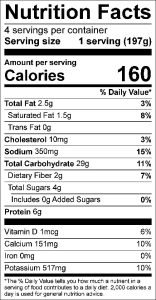 Serves: 4 | Serving Size: 1 cup
Serves: 4 | Serving Size: 1 cup
Ingredients Needed:
- 3 medium potatoes, peeled and sliced
- 1 teaspoon flour
- ½ teaspoon salt
- ¼ teaspoon pepper
- 2 teaspoons soft butter
- ¼ cup grated low-fat Swiss cheese
- 1 cup fat-free milk
Directions
- Grease a 2-quart casserole dish (microwavable).
- Cover the bottom of the dish with a layer of potatoes. Dot with some (about ⅓) of the butter. Sprinkle with part of the flour, salt, and pepper. Repeat layering until all potatoes are used, about two to three layers.
- Sprinkle cheese over the top layer; pour milk over the potatoes. Cover the dish with plastic wrap, tightly cover it so the plastic wrap doesn’t touch the food, then lift one corner to allow ventilation.
- Microwave on high for 10–12 minutes.
- Place under broiler for two to three minutes to brown.
Fried Rice
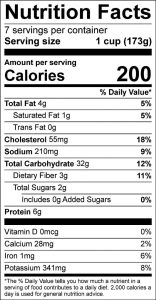 Serves: 7 | Serving Size: 1 cup
Serves: 7 | Serving Size: 1 cup
Ingredients Needed:
- 2 teaspoons vegetable oil
- 1 small onion, chopped
- ¼ teaspoon ground ginger or 1 tablespoon fresh chopped ginger
- 1 tablespoon minced garlic
- 2 eggs, beaten
- 4 cups cooked rice
- 1½ cups frozen peas or mixed frozen peas and carrots
- 2 tablespoons reduced-sodium soy sauce
Directions
- Heat oil in a large skillet.
- Over medium heat, sauté onions, ginger, and garlic until fragrant.
- Add eggs, and scramble.
- Stir in rice, peas, and soy sauce.
- Continue to stir over low heat for five to six minutes and serve hot.
Tip:
Fresh diced carrots, peppers, and celery can also be added in step #2.
Photos: All photos property of University of Maine Cooperative Extension, unless otherwise noted.
Information in this publication is provided purely for educational purposes. No responsibility is assumed for any problems associated with the use of products or services mentioned. No endorsement of products or companies is intended, nor is criticism of unnamed products or companies implied.
© 2023
Call 800.287.0274 (in Maine), or 207.581.3188, for information on publications and program offerings from University of Maine Cooperative Extension, or visit extension.umaine.edu.
In complying with the letter and spirit of applicable laws and pursuing its own goals of diversity, the University of Maine System does not discriminate on the grounds of race, color, religion, sex, sexual orientation, transgender status, gender, gender identity or expression, ethnicity, national origin, citizenship status, familial status, ancestry, age, disability physical or mental, genetic information, or veterans or military status in employment, education, and all other programs and activities. The University provides reasonable accommodations to qualified individuals with disabilities upon request. The following person has been designated to handle inquiries regarding non-discrimination policies: Director of Equal Opportunity, 101 Boudreau Hall, University of Maine, Orono, ME 04469-5754, 207.581.1226, TTY 711 (Maine Relay System).

